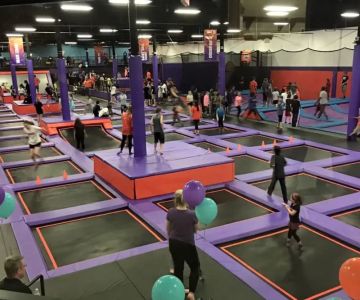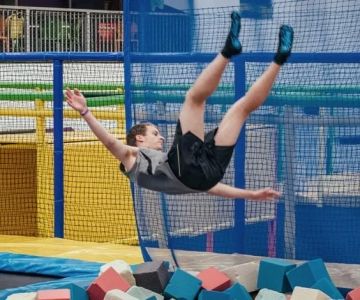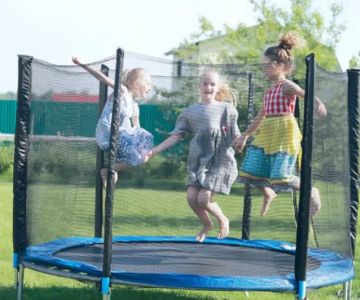- 1-Importance-of-a-Bounce-Schedule-for-Kids
- 2-Assessing-Your-Childs-Age-and-Activity-Level
- 3-Step-by-Step-Guide-to-Creating-a-Bounce-Schedule
- 4-Safety-Tips-to-Include-in-Your-Bounce-Schedule
- 5-Case-Study-a-Successful-Family-Bounce-Routine
- 6-How-to-Keep-Kids-Motivated-and-Engaged
- 7-Resources-and-Products-from-Trampoline-Zone
1. Importance of a Bounce Schedule for Kids
Creating a bounce schedule for kids encourages regular physical activity, which is essential for healthy growth, coordination, and overall fitness. Trampoline bouncing is an enjoyable way to help children expend energy, develop motor skills, and improve balance. A well-structured schedule also prevents overuse injuries and promotes good habits.
2. Assessing Your Child’s Age and Activity Level
Before designing a bounce schedule, consider your child’s age, stamina, and interest. Younger children may benefit from shorter, more frequent sessions, while older kids can handle longer bounce times. Understanding your child’s baseline activity helps tailor the schedule to their needs without overwhelming them.
3. Step-by-Step Guide to Creating a Bounce Schedule
Begin by deciding how many days per week your child will bounce. Experts recommend 3-5 days, allowing rest days for recovery. Set time limits per session based on age: 10-15 minutes for toddlers, up to 30 minutes for older children.
Incorporate warm-up and cool-down periods, encouraging stretching before and after bouncing. Plan variety in bounce activities—such as simple jumps, games, or trampoline exercises—to keep sessions engaging.
4. Safety Tips to Include in Your Bounce Schedule
Safety should be a priority. Ensure the trampoline has safety nets and padding. Supervise bounce times, especially for younger children. Encourage proper footwear or barefoot bouncing and keep the trampoline area clear of hazards. Limit consecutive bounce time to avoid fatigue and potential accidents.
5. Case Study: A Successful Family Bounce Routine
The Johnson family implemented a bounce schedule for their three kids aged 4, 7, and 10. They created a chart with daily bounce goals, mixed with fun challenges like who can do the highest jump or longest bounce. Over months, they noticed improved energy levels and better sleep habits. Their story illustrates how structure combined with fun promotes lasting benefits.
6. How to Keep Kids Motivated and Engaged
Using rewards, turning bouncing into games, and setting achievable goals helps maintain enthusiasm. Rotate trampoline activities to prevent boredom and celebrate milestones to boost confidence.
7. Resources and Products from Trampoline Zone
For families seeking quality trampolines and accessories to support a bounce schedule, Trampoline Zone offers expert recommendations and trusted products. Their resources help you create a safe, fun environment where kids can thrive physically and emotionally through bouncing.







 Zap Zone XL4.0 (2483 reviews)
Zap Zone XL4.0 (2483 reviews) We Rock the Spectrum - Northeast Philly4.0 (190 reviews)
We Rock the Spectrum - Northeast Philly4.0 (190 reviews) Westbank Village Shopping Center4.0 (539 reviews)
Westbank Village Shopping Center4.0 (539 reviews) Super Sky High Bungee5.0 (1 reviews)
Super Sky High Bungee5.0 (1 reviews) Boomers Santa Maria4.0 (1904 reviews)
Boomers Santa Maria4.0 (1904 reviews) Get Air Pickerington4.0 (651 reviews)
Get Air Pickerington4.0 (651 reviews) Are Trampoline Parks Safe for Kids? Essential Guide for U.S. Parents
Are Trampoline Parks Safe for Kids? Essential Guide for U.S. Parents How Often Should You Replace Trampoline Springs? Tips for Proper Maintenance
How Often Should You Replace Trampoline Springs? Tips for Proper Maintenance How Much Is a Trampoline? A Detailed Guide to Trampoline Costs and Buying Tips
How Much Is a Trampoline? A Detailed Guide to Trampoline Costs and Buying Tips Bounce Techniques for Stronger Legs: Effective Exercises and Tips
Bounce Techniques for Stronger Legs: Effective Exercises and Tips Essential Music Gear for Trampoline Dance: Complete Guide
Essential Music Gear for Trampoline Dance: Complete Guide Fun STEM Experiments Using Trampolines to Spark Curiosity and Learning
Fun STEM Experiments Using Trampolines to Spark Curiosity and Learning